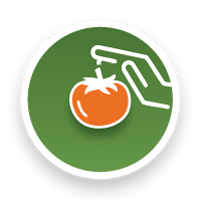
Welcome Shoppers!
Quick Consumer Guide to Choosing High-Quality Food
You don’t need to be a farmer or a scientist to choose better food.
Use your senses, ask a few questions, and trust your body’s feedback.
SMELL
GOOD FOOD HAS NOTHING TO HIDE
Aromatic = Better. Quality produce has a noticeable, pleasant smell (think ripe peaches, tomatoes, herbs).
No scent = Grown for storage, not flavor.
Trust Your Nose for Off Odors
Fresh Should Smell Fresh. Meats, fish, and dairy should have clean, mild scents. A sour, metallic, fishy, or ammonia-like smell means it’s past its prime—even if the date says its ok.
🎯TRY THIS: Smell a store tomato vs. a market tomato. The difference is obvious.
FEEL
YOUR HANDS FEEL WHAT’S FRESH
Produce should feel alive and hydrated — not limp, shriveled, or spongey.
Freshness shows through firmness and bounce.Heavier usually means denser — and more nutrient-packed.
When in doubt, pick the one that feels more solid for its size.Tension tells the truth.
Snap a bean, bend a top, press a leaf — fresh produce resists gently, not weakly.
🎯TRY THIS: At the market, find the ugliest tomato you can. Then find the prettiest. Which has best story?

Let YOUR Senses Judge the Freshness!
LOOK
REAL FOOD DOESN’T ALWAYS LOOK PERFECT
Rich, deep colors often signal higher nutrient density (e.g., dark green spinach).
Pale or washed-out produce? Often a sign it was picked early and ripened artificially.
Shape: Slightly irregular shapes are OK! Uniform produce often signals industrial farming.
Nature isn’t perfect.Avoid produce that looks overly waxed, shiny, or dried. Natural skin should feel alive—firm, not brittle; matte, not plastic.
🎯TRY THIS: At the market, find the ugliest tomato you can. Then find the prettiest. Which has best story?
ASK
CURIOUS SHOPPERS GET BETTER FOOD
“Was this grown for flavor and nutrition, or for yield and shelf life?” Reveals if quality mattered more than output.
“What are your personal favorites right now?”
Farmers eat the best — their picks show what’s truly ripe.“Do you know when this was picked?” Just one extra day can impact taste and nutrients.
“How was it grown or raised?”
Soil, feed, and care shape both flavor and nutrition.
🎯TRY THIS: Ask one vendor what they wouldn’t buy from their own stand today. You’ll learn more in 30 seconds than an hour of Googling.

The More YOU Notice, the Better YOU Eat!
TASTE
TRUST YOUR TASTE BUDS — THEY KNOW
Farmers markets and grocery stores often offer samples.
Sweet, rich flavor usually = more minerals and better-growing conditions.
Bland or watery = likely lower quality.
🎯TRY THIS: One bite is worth a thousand claims. Taste before you trust it.
STORY
BEHIND EVERY BITE, THERE’S A STORY
Ask: “Do you know the grower?” “Where was this grown?” or “What are your farming practices?”
Food grown with care often comes with a name, a place, or a method (e.g., cover cropping, compost, no synthetic inputs).
🎯TRY THIS: Ask who grew it and how. Good food usually comes with a name.

Real Food Has a Story—& YOU Can Taste It.
PERIMETER
THE PERIMETER IS SMART—JUST NOT FOOLPROOF
Whole foods live here — fresh, perishable, and less processed.
Fewer additives — shorter ingredient lists, more real food.
In-season produce — better taste, better price.
Stay alert — not everything on the edge is healthy.
Challenge to create a shopping cart that resembles this (image of comparison of 1960’s groceries vs now)
🎯TRY THIS: Fill your cart with only perimeter foods—produce, meat, dairy, eggs, and fresh staples. Snap a photo and compare it to a 1960s grocery haul. How close can you get?
REFRACTOMETER
BONUS THING-TO-DO
Measures Brix, a proxy for sugar + mineral content.
Simple to use. A higher Brix reading usually = better nutrition.
Buy one online for ~$25–$40 and use with a drop of juice. (become a member to purchase our Brix kit)
Host a Brix party- comparing the flavor, aroma, and Brix reading of locally sources/purchased item (link to Brix chart)
🎯TRY THIS: Get a refractometer and host a “Brix tasting party.” Compare flavor, smell, and Brix readings of fresh produce—see if your taste buds match the numbers.
Final Tip from Bionutrient Food Association Executive Director - Dan Kittredge:
Go Slow, One Step at a Time
“You don’t have to change everything at once. Start by choosing one high-quality item per week. Over time, your taste buds, energy, and health will notice the difference.”
Share your story
QR code
Buy a Bionutrient Brix Meter Kit
The Real Cost of Cheap Food
Link to Real Cost of Processed Foods: The Real Cost of Cheap, Processed Foods









